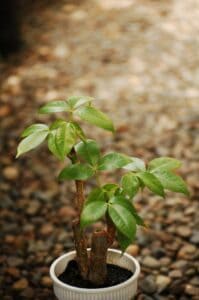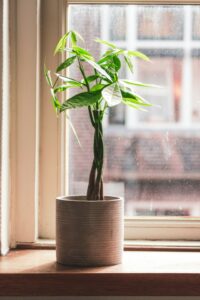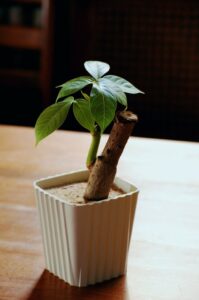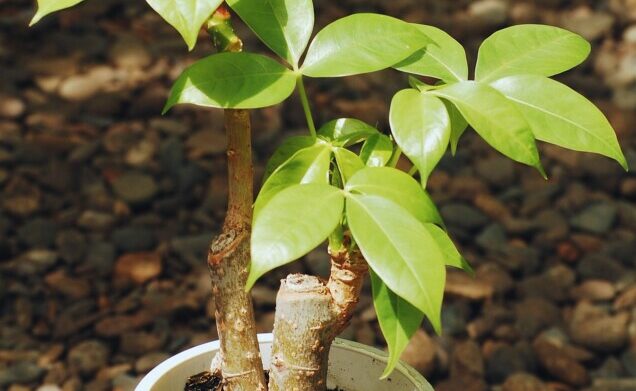Some links in the post are affiliate links and I get a commission from purchases made through some links found in the post.
Leaf yellowing is normal, right? At least that’s what my neighbor thought about her beloved money tree.
It had been around for quite a while, and once she noticed the yellowing, she thought it was old age.
She had the tree around for superstitious reasons, believing that the more it grew, the fatter her bank account would be.
So, the thought of a dying tree was not welcome. “It has to be age,” she said, dismissing my notion that there was more to it.
And with a smile, she watered the tree some more, stating that it would be back to life. Sadly, the tree (well) died. The reason? – Overwatering! That had been the cause of the yellowing all along.
My dear neighbor, worried sick that this death would spell bad news for her bank account, bought another money tree soon afterward.
But this time, she was keen on keeping the leaves from yellowing. We soon realized that overwatering was but one cause of yellowing.
The reasons your money tree leaves are turning yellow included overwatering, underwatering, poor lighting, poor feeding, temperature changes, and humidity imbalances. Whoa! That’s quite a list.
I’ll walk you through what could be causing yellowing in your plant, what you can do about it, and what happens if you sit back and wait.
Why Are My Money Tree Leaves Turning Yellow?
 I love telling this money tree story because my neighbor is quite an interesting, charming lady.
I love telling this money tree story because my neighbor is quite an interesting, charming lady.
For the few days that her money tree was on its somewhat deathbed, she kept checking her bank account.
She somehow thought that the money would disappear if the tree died. And if you believe that money trees spell luck on your fortune, you might be feeling the same way.
So, before I get into what could be triggering the yellowing, I should note that her funds were safe. Now that we have that out of the way, what could be the problem?
1) Poor Watering Practices
Watering our plants is a form of love. We can’t buy them gifts or shower them with praises, so we give them water. But how much do money trees need?
They need regular watering, but there is a huge caveat to this – you should only water them when the top soil inch is dry. What can go wrong if you don’t follow this rule of thumb?
Overwatering
Most of the time the leaves on a money tree turning yellow results from overwatering. It’s when you give your plant more love than it needs.
Or when the soil has poor drainage or the pot does not have adequate holes. An overwatered money tree shows its distress in the following ways:
- The soil appears wet almost always and may even have some mold growing on the surface. It may even attract pests,
- The soil has a pungent smell akin to rotting – this is a sign that root rot has begun and is slowly killing the plant from underneath,
- The plant has spots or brown edges on its leaves. Some of the lower leaves may start falling off.
Unfortunately, root rot spreads fast, and if you don’t deal with it as soon as it exhibits, your plant can die.
Underwatering
While the money tree can die from too much watering, it does not particularly enjoy neglect. And if you leave it without enough water for too long, it can start yellowing. Moreover, it starts displaying signs of neglect such as:
- Curling or drying of the leaves,
- Evident drying of the soil. The surface can even start cracking,
- Leaf loss
An underwatered plant looks weak, and if left like this for too long, the tree can die. After all, without water, cellular activities cannot occur, and the plant cannot support itself.
How Can You Avoid Poor Watering Regimes?
Before watering your tree, you should always check the topmost soil layer. If it feels dry to the touch, you can water the soil.
But if not, you can wait a few more days and check again. Sometimes, people have a hard time gauging if the soil is dry. In that case, you can get a moisture gauge to help you with the assessment to be sure.
When watering the plant, soak the soil and allow the excess water to drain. Then leave the plant to absorb the water before watering it again.
If you’re enjoying this article, check out our article on why are my money tree leaves drooping.
2) Poor Lighting
Here’s the interesting thing about money trees. In the outdoors, they can grow in direct sunlight and thrive. But the minute you move them indoors, they suddenly become allergic to direct sun.
They prefer bright indirect light and can even do well in medium indirect light. The deal gets even better – they can do well in artificial light.
Give them six hours of exposure, and they will be good to go. So, how could you possibly go wrong with the lighting?
Too Much Light
When your money tree has too much exposure to direct sun, it becomes dehydrated. Moreover, its chlorophyll levels reduce, resulting in a pale-looking tree.
In some cases, the sun can be so hot that it scorches the leaves, inducing browning on the edges.
Too Little Light
The money tree is quite forgiving when it comes to poor lighting conditions. However, there is only so much it can tolerate.
At some point, it starts showing signs that all is not well. These include stunted growth and the leaves of your money tree turning yellow. The plant may also appear weak.
How Can You Fix Lighting Issues?
With the money tree, your safest bet lies in embracing balance – don’t give it too much nor too little lighting.
Ideally, you should place the plant near an east or west-facing window where it can receive dappled sunlight in the morning or afternoon.
If the exposure still causes yellowing and browning, add a sheet to protect the plant from direct light.
But if you live in an area with poor lighting, you should locate the plant near a south-facing window where it can get more light.
Suppose the lighting is still not enough. You can supplement the existing light with some fluorescent lighting.
For more information on light requirements, check out our article on the money tree light requirements.
3) Feeding Issues
Another way we show love to our plants is by feeding them. And just like with water, we can be overzealous with it or could neglect the plants for far too long. So, what happens when we fail to feed the plant properly?
Underfeeding
 The money tree cannot survive without essential nutrients for too long. These include manganese, nitrogen, and potassium.
The money tree cannot survive without essential nutrients for too long. These include manganese, nitrogen, and potassium.
And when you grow it in a pot, it does not have many sources of nutrients as it cannot source them from its environment. It’s up to you to feed it regularly to ensure that it does not lack what it needs.
Otherwise, its leaves start yellowing because optimal cellular activity cannot occur without these nutrients. Furthermore, the plant’s growth stunts, its leaves curl, and the foliage appears abnormally green.
Overfeeding
The other issue some gardeners face is they don’t know when to stop feeding their plants.
So, they keep adding nutrients, causing saturation in the potting mix. And when that happens, the fertilizer can burn the roots.
It can also create unfavorable growing conditions that limit the plant’s ability to thrive. Yellowing is but one of the ways the plant can react to these changes.
Others include leaf burn, stunted growth, falling of leaves, the appearance of crusts on the potting mix surface, and browning of the leaves.
If you do not cut back on feeding the plant, the excess fertilizer can burn and damage the roots, leading to the death of your tree.
How to Protect Your Plant
Just like overwatering, overfeeding your plant can spell disaster for your tree. So, what’s the best approach in this case? You should follow a strict feeding schedule.
Feed your plant once every month in the spring and summer. During these seasons, the plant will be in active growth, and the fertilizer will go into good use.
But in the fall, the plant will not be actively growing. In that case, you can cut back to every other month. You should not feed the plant in winter because it will be dormant, and the feeding will only harm the plant.
If you have been overfeeding your plant, flush its potting mix with water, allowing the excess water to drain. Do this by placing the plant under running water for five to ten minutes.
Then leave the potting mix to dry and do not feed the plant again for at least a month. When you finally do, use a basic fertilizer diluted to half its strength.
If your plant is underfed, you can keep up with the monthly feeding schedule. And when feeding the plant, always ensure the soil is moist.
It’s always best to incorporate the feeding with watering, so the plant has time to absorb the nutrients before the next watering session.
4) Humidity and Temperature Changes
Money trees enjoy being in humid conditions, seeing as they are native to Central and South America.
Ideally, they should be in rooms with humidity of at least 50% and temperatures between 65- and 80-degrees Fahrenheit.
Even so, you find that most homes do not have humidity levels this high. Most average 30% to 50%, which is pretty low.
Over time, this catches up with the plant, which starts exhibiting yellowing and even browning on the edges. If you do not act fast, the plant leaves start falling off, including the immature ones.
Humidity issues are often prevalent in the winter owing to the sudden drop in temperature and humidity levels. So, you might need to keep an eye out for any yellowing that comes about in the colder months.
How Can You Fix These Issues?
The first thing to note is that humidity and temperature are closely related. If your temperatures are low, maintaining a high humidity level will be hard.
So, you must locate the plant in a warm room or near a heater. However, please do not place the plant near any warm or cold drafts as these can damage its leaves.
Find a sheltered location that has a high temperature range. A kitchen would be a good start. A bathroom is also a favorable option.
The next thing lies in testing the humidity of the room. Is it high enough? If your air is mostly dry, you can alter this by using a humidifier.
Or you can place the plant pot on a tray with pebbles and water. As the water evaporates, it will create a high humidity level around the plant.
Alternatively, you can leave the plant in the bathroom or kitchen, as these rooms generally have a high humidity level.
Misting is also an option. However, since it is a bit labor-intensive, it would not be my first recommendation due to its limited sustainability. Some people also bathe their trees which is also a bit involving.
The best solution lies in placing the plant away from cold and hot drafts and ensuring that its immediate environment is humid.
You may also like: Money tree vs money plant
5) The Rootbound Money Tree
 Could the leaves turning yellow signify that your money tree is too big for its current pot? Sure! The money tree grows relatively fast and needs to be repotted every two to three years.
Could the leaves turning yellow signify that your money tree is too big for its current pot? Sure! The money tree grows relatively fast and needs to be repotted every two to three years.
If you do not change its pot, the roots become rootbound, unable to absorb adequate nutrients to support the plant.
Eventually, the plant starts showing signs of yellowing, which is a clear indication that the plant needs a pot change.
How can you tell your plant is rootbound? Besides yellowing, you can notice signs such as:
- Water welling up on the surface rather than draining out of the pot,
- Roots poking out of the drainage holes, and
- Curling of roots inside the pot.
If your plant shows any of these signs, you can repot it in a pot one size bigger than the current one.
It’s best to do this in spring and summer as the plant is actively growing. Doing so in winter can send the dormant plant into shock.
Final Thoughts
Was my neighbor right about the old age approach? Sure! Older leaves can turn yellow before browning and falling off the money tree. And this is quite normal.
It’s even a good thing because it paves the way for newer growth. But if your money tree leaves are turning yellow before they mature, that’s not normal.
You need to consider what else could be promoting yellowing and what you can do about it.
That said, Happy Gardening!
Before you go, here are some more related articles I encourage you to read below to help solve more of your gardening issues:

